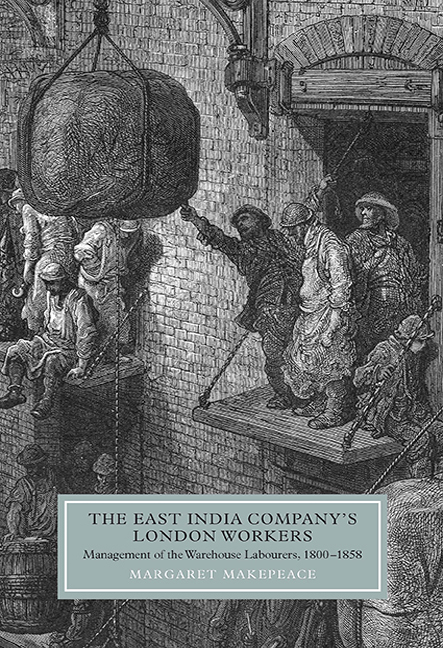Book contents
- Frontmatter
- Contents
- Figures and tables
- Dedication
- Acknowledgements
- Abbreviations
- 1 Introduction
- 2 The East India Company Warehouses
- 3 The Warehouse Labourers
- 4 Management Strategies: Incentives, Rewards and Benevolence
- 5 Management Strategies: Systems of Internal Control
- 6 The Royal East India Volunteers: The ‘Union of Civil and Military Dependence’
- 7 The Relationship Between the East India Company and its London Warehouse Labourers
- 8 The Warehouse Closures
- 9 Management of the Warehouse Labourers and Pensioners 1838–1858
- Conclusion: ‘Good Masters to the Lower Class of Their Dependents’
- Bibliography
- Index
4 - Management Strategies: Incentives, Rewards and Benevolence
Published online by Cambridge University Press: 13 April 2017
- Frontmatter
- Contents
- Figures and tables
- Dedication
- Acknowledgements
- Abbreviations
- 1 Introduction
- 2 The East India Company Warehouses
- 3 The Warehouse Labourers
- 4 Management Strategies: Incentives, Rewards and Benevolence
- 5 Management Strategies: Systems of Internal Control
- 6 The Royal East India Volunteers: The ‘Union of Civil and Military Dependence’
- 7 The Relationship Between the East India Company and its London Warehouse Labourers
- 8 The Warehouse Closures
- 9 Management of the Warehouse Labourers and Pensioners 1838–1858
- Conclusion: ‘Good Masters to the Lower Class of Their Dependents’
- Bibliography
- Index
Summary
IN ORDER to manage the very large body of labourers, the East India Company operated a paternalistic ‘carrot and stick’ approach, with the aim of keeping the warehouses functioning at an acceptable level of efficiency and of guarding against transgression. The Company's management ‘carrots’, which were offset by the ‘sticks’ described in the next chapter, were positive incentives to encourage the formation of a stable and committed workforce in the warehouses. Although Sidney Pollard has written that it was only in about 1830 that ‘common humanity began to combine with self-interest among the larger or more honourable employers’, this chapter will argue that the East India Company was displaying this trait from a far earlier date, and it will also suggest that the directors were not as parsimonious and mean spirited as many of their contemporary critics asserted.
Some of the benefits and rewards offered by the Company in a bid to retain the labourers it had selected have already been discussed in Chapter 3: fair cash wages distributed regularly and reliably each week; a short standard working day allowing the men to seek sources of supplementary earnings; overtime payments; and promotion opportunities for ‘deserving’ labourers. There were no pay incentives for the labourer grade based solely on longevity of service or efficiency. Apart from the lower rate for junior labourers, pay was not related to age or experience: a man in his forties was paid the same basic daily rate as a twenty-year-old; nor was a man's basic pay related to output or performance. Rates were reviewed periodically; for example, the warehouse labourers’ daily wages were increased in May 1810 from 2s 6d per day to 2s 9d per day ‘during the pleasure of the Court’, and new pay regulations were introduced in June 1818 for warehouse commodores and writers. Commodores who had served in that capacity from five to less than ten years were to receive 9d per day more than a labourer, instead of the current rate of 6d.
- Type
- Chapter
- Information
- The East India Company's London WorkersManagement of the Warehouse Labourers, 1800–1858, pp. 67 - 93Publisher: Boydell & BrewerPrint publication year: 2010



